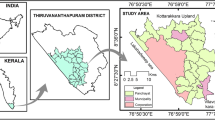Abstract.
Leapfrogging appears at several levels and hence may be one of the fundamental processes generating urban fractality. Simulations have been performed on random pockets (slums) with different areas and lifetime of the Delhi city. The images were procured and processed using GIS package SAS planet and ImageJ and the fractal dimension was calculated by the box-counting method. In addition, we propose a confined leapfrogging model. Both studies suggests that any such confined pocket shall eventually have a high fractal dimension in the range 1.65-1.85 with a central tendency of 1.76 from the data of pockets and 1.78 from the confined model. These slums will approach a high fractal dimension due to the high level of social and economic pressure there. The confined leapfrogging model is suggested as the underlying process of slum growth.
Similar content being viewed by others
References
B.B. Mandelbrot, The Fractal Geometry of Nature (W.H. Freeman and Company, San Francisco, 1982)
A.N. Kolmogorov, Dokl. Akad. Nauk SSSR 30, 301 (1941)
A.N. Kolmogorov, J. Fluid Mech. 13, 82 (1962)
B.B. Mandelbrot, Science 155, 636 (1967)
B.B. Mandelbrot, Fractals: Form, Chance and Dimension (W.H. Freeman and Company, New York, 1977)
H.O. Peitgen, P.H. Richter, The Beauty of Fractals (Springer Verlag, New York, 1986)
J. Feder, Fractals (Plenum Press, New York, 1988)
M. Fleischmann, D.J. Tildesley, R.C. Ball, Fractals in the Natural Sciences (Princeton University Press, Princeton, NJ, 1990)
H. Lauwerier, Fractals, Endlessly Repeated Geometrical Figures (Princeton University Press, Princeton, NJ, 1991)
J.P. Briggs, Fractals: The Patterns of Chaos: Discovering a New Aesthetic of Art, Science and Nature (Simon & Schuster, 1992)
L.S. Liebovitch, Fractals and Chaos - Simplified for the Life Sciences (Oxford University Press, USA, 1998)
S.H. Strogatz, Nonlinear Dynamics And Chaos: With Applications To Physics, Biology, Chemistry and Engineering (Studies in nonlinearity) (Westview Press, 2001)
B.B. Mandelbrot, Fractals and Chaos, The Mandelbrot Set and Beyond (Springer Verlag, New York, 2004)
K. Falconer, Fractal geometry: mathematical foundations and applications (John Wiley & Sons, 2004)
P.C. Ivanov et al., Nature 399, 461 (1999)
Y. Ashkenazy et al., Phys. Rev. Lett. 86, 1900 (2001)
R.D. King et al., Brain Imaging Behav. 3, 154 (2009)
H.E. Stanley, P. Meakin, Nature 335, 405 (1988)
X. Zhang et al., ACS Nano 9, 11909 (2015)
D. Koutsoyiannis, Hydrol. Sci. J. 48, 3 (2003)
W. Schlager, Geology 32, 185 (2004)
R.J. Bailey, D.G. Smith, Proc. Geo. Assoc. 116, 129 (2005)
B.B. Mandelbrot, D.E. Passoja, A.J. Paullay, Nature 308, 721 (1984)
A.R.T. Jonkers, Phys. Earth Planet. Int. 135, 253 (2003)
T. Gneiting, M. Schlather, SIAM Rev. 46, 269 (2004)
H.B. Li et al., Nature 520, 518 (2015)
W. Willinger, M.S. Taqqu, V. Teverovsky, Finance Stochast. 3, 1 (1999)
D. Dejniak, Inform. Syst. Manag. 3, 113 (2014)
W.E. Leland, M.S. Taqqu, W. Willinger, D.V. Wilson, IEEE/ACM Trans. Netw. 2, 1 (1994)
T. Karagiannis, M. Molle, M. Faloutsos, IEEE Internet Comput. 8, 57 (2004)
C. Song, S. Havlin, H.A. Makse, Nature 433, 392 (2005)
B. Jiang, Y. Miao, Professional Geograph. 67, 295 (2015)
B. Jiang, Int. J. Geograph. Inf. Sci. 29, 159 (2015)
S. Soumya et al., Eur. Phys. J. Plus 132, 551 (2017)
M. von Korff, T. Sander, Sci. Rep. 9, 967 (2019)
N.L. Rashevsky, Bull. Math. Biophys. 17, 229 (1955)
Z. He, Sci. Rep. 8, 10324 (2018)
L.F. Richardson, Gen. Syst. Yearb. 6, 139 (1961)
S.L. Arlinghaus, Geograf. Ann. B 67, 83 (1985)
M. Batty, Environ. Plan. B 14, 123 (1987)
P. Frankhauser, L’Espace Geograph. 19, 45 (1990)
M. Batty, P. Longley, Fractal Cities: A Geometry of Form and Function (Academic Press, London, 1994)
M. Batty, Nature 377, 574 (1995)
S. Salat, L. Bourdic, C. Nowacki, Int J. Sustain. Build. Tech. Urban Dev. 1, 160 (2010)
Y. Zhang, J. Yu, W. Fan, Geo-spatial Inf. Sci. 11, 121 (2008)
M. Ge, Q. Lin, Geo-spatial Inf. Sci. 12, 265 (2009)
L. Benguigui, D. Czamanski, M. Marinov, Y. Portugali, Environ. Plan. B 27, 507 (2000)
S. Jiang, D. Liu, Int. J. Artif. Life Res. 3, 41 (2012)
H.A. Makse, S. Havlin, H.E. Stanley, Nature 377, 608 (1995)
F. Hausdorff, Math. Ann. 79, 157 (1919)
L. Benguigui, D. Czamanski, Geograph. Anal. 36, 69 (2004)
T. Vicsek, J. Phys. A 16, L647 (1983)
L. Benguigui, J. Phys. I 2, 385 (1992)
L. Benguigui, Environ. Plan. A 27, 1147 (1995)
M.F. Barnsley, Fractals Everywhere (Academic Press, Boston, MA, 1988)
B.B. Mandelbrot, The Fractal Geometry of Nature (W.H. Freeman and Co, NY, 1983)
S.A. Pruess, Fractals in Earth Sciences: Some Remarks on the Numerical Estimation of Fractal Dimension (Plenum Press, NY, 1995)
L. Benguigui, D. Czamanski, M. Marinov, Urb. Stud. 38, 1819 (2001)
S. McKillup, Statistics Explained: An Introductory Guide for Life Scientists (Cambridge University Press, New Delhi, India, 2011)
Author information
Authors and Affiliations
Corresponding author
Additional information
Publisher’s Note
The EPJ Publishers remain neutral with regard to jurisdictional claims in published maps and institutional affiliations.
Rights and permissions
About this article
Cite this article
Kumar Singh, S., Ashish, Talan, J. et al. Simulation of confined pocket of a city by leapfrogging method. Eur. Phys. J. Plus 134, 550 (2019). https://doi.org/10.1140/epjp/i2019-12993-2
Received:
Accepted:
Published:
DOI: https://doi.org/10.1140/epjp/i2019-12993-2




